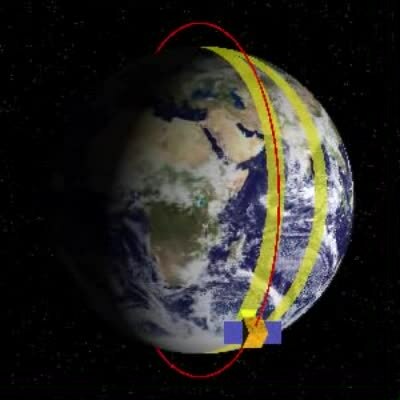See full list on nasa.fandom.com. The National Oceanic and Atmospheric Administration, NOAA, has several different types of satellites, including geostationary and polar orbiting satellites. These datasets show the path of Polar-orbiting Operational Environmental Satellites, or POES for short. NOAA has two POES in operation currently, a morning and afternoon satellite. The polar satellites revolve around the Earth in a north-south orbit passing over the poles as the Earth spins about its north-south axis. It is a satellite whose orbit is perpendicular or at right angles to the equator, or in simple words it passes over the north and south poles as it orbits the earth. Polar orbits are a type of low Earth orbit, as they are at low altitudes between 200 to 1000 km. Sun-synchronous orbit (SSO) is a particular kind of polar orbit. Satellites in SSO, travelling over the polar regions, are synchronous with the Sun. This means they are synchronised to always be in the same ‘fixed’ position relative to the Sun.
- See Full List On Earthobservatory.nasa.gov
- Polar Orbiting Satellite Definition
- Sun Synchronous Polar Orbit
Learn about this topic in these articles:
spaceflight
- In spaceflight: Earth orbit
…to be put into a polar orbit—an orbit that crosses over Earth’s poles—it is launched in a northerly or southerly direction. Although the benefit of an easterly launch is lost, a spacecraft in an orbit perpendicular to the Equator offers other advantages. As Earth turns on its axis, the spacecraft…
Read More
weather satellites
- In weather forecasting: Meteorological measurements from satellites and aircraft
Strategic vista usb devices driver download for windows 10. …two principal types: the low-flying polar orbiter, and the geostationary orbiter.
Read More - In space exploration: Meteorology
…in a north-south direction, called polar orbits, can obtain more detailed data about changing atmospheric conditions. They also provide repetitive global coverage as Earth rotates beneath their orbit. In the United States, military and civilian agencies each have developed independent polar-orbiting meteorological satellite systems; China, Europe, and Russia also have…
Read More
Northrop Grumman on May 18 won a contract worth up to $2.4 billion to supply two polar orbit satellites that are part of the next generation of missile warning systems. Sound laptops & desktops driver download for windows.
“This modification adds phase one for design/development, critical path flight hardware procurement, and risk-reduction efforts leading to a critical design review to the basic contract,” the Defense Department said in a contract announcement.

Phase one development work will run through the end of 2025, and another contract that will fund production, testing, and launch is due out in fiscal 2022. The Space Force wants the first polar satellite in fiscal 2027 and all five initial satellites ready for operations in 2029.
The new Overhead Persistent Infrared constellation includes two satellites in polar orbit and three in geosynchronous Earth orbit as part of Block 0. Lockheed Martin is on contract to develop the GEO satellites. The Space Force plans to take competitive bids for additional batches of satellites to replace the Space-Based Infrared System.
See Full List On Earthobservatory.nasa.gov
“The primary mission is to provide initial missile warning of a ballistic missile attack on the U.S., its deployed forces, and its allies,” according to Space Force budget documents. “Next-Gen OPIR Space enhances detection and improves reporting of intercontinental ballistic missile launches, submarine launched ballistic missile launches, and tactical ballistic missile launches.”
Air Force officials have tried to speed along the program by asking Congress to shift hundreds of millions of dollars at a time to backfill the OPIR account. The department wants $2.3 billion for OPIR development in fiscal 2021 alone.
Polar Orbiting Satellite Definition

Sun Synchronous Polar Orbit
The research and development program is slated to cost $14.5 billion from 2020 through 2025. Budget documents show the total price tag is still in flux.
